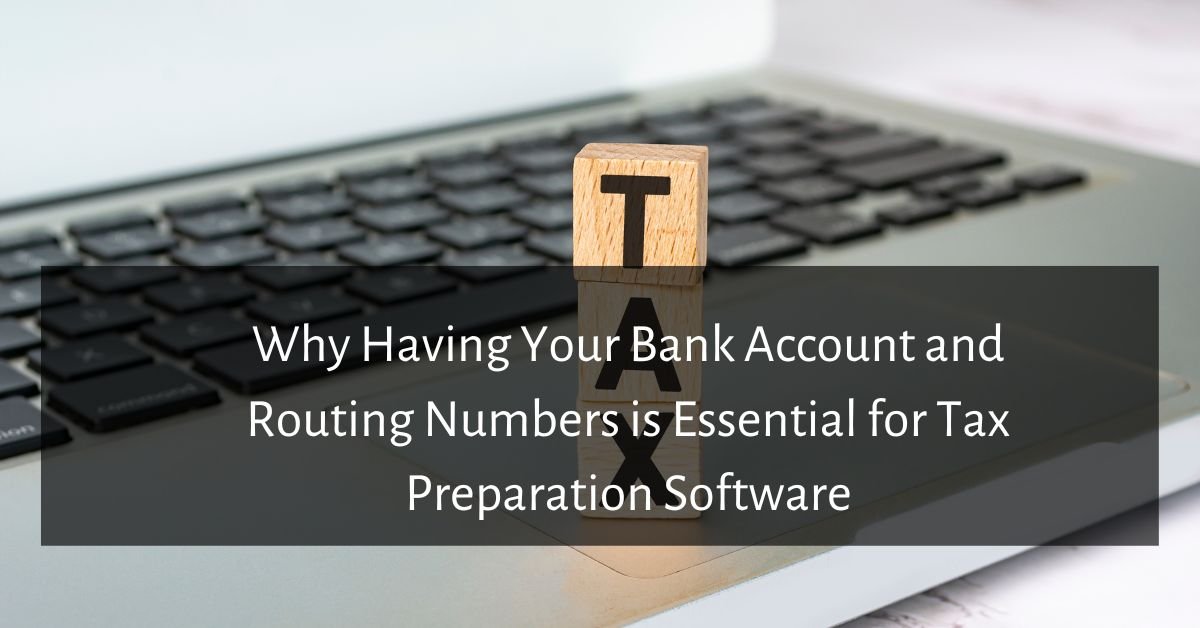Tax season arrives like clockwork, and with it comes the annual responsibility of filing taxes. In this digital age, technology has significantly streamlined the tax preparation process. Yet, amidst the convenience, a crucial requirement stands out: the necessity of having access to your bank account and routing numbers when using tax preparation software.
The Significance of Bank Account and Routing Numbers in Tax Preparation Software
Defining Bank Account and Routing Numbers
Before delving deeper, it’s pivotal to comprehend what these numbers entail. The bank account number functions as a unique identifier for your account, while the routing number indicates the financial institution’s location. Together, they form the backbone for secure financial transactions.
Enabling Secure and Swift Direct Deposits
One of the primary advantages of furnishing accurate bank details is the facilitation of secure direct deposits. Opting for direct deposit ensures tax refunds or payments are received swiftly and securely, eliminating the hassle of physical checks and reducing the risks associated with them, such as loss or theft.
Facilitating Error-Free E-filing
Integration of bank details into tax software contributes significantly to accurate e-filing of tax returns. This integration minimizes errors that might arise due to manual input, ensuring precision in financial transactions.
Efficiency and Convenience in Tax Payments
Simplifying Tax Payments with Direct Debit
By providing your bank account information, tax payments can be simplified through direct debit. This streamlines the payment process, decreasing the likelihood of errors commonly associated with manual payment submissions.
Mitigating Errors and Delays
Accurate bank details play a pivotal role in preventing errors or delays that might occur due to incorrect payment information. Timely tax payments are crucial in avoiding penalties or fines, making the provision of accurate bank information essential.
Enhanced Security and Fraud Prevention
The incorporation of bank account and routing numbers within tax preparation software ensures encrypted and secure transmission of financial data. This feature significantly reduces the vulnerability to data breaches or unauthorized access.
Identity Verification and Prevention of Unauthorized Transactions
These details also aid in verifying the taxpayer’s identity, serving as an additional layer of security against unauthorized transactions or fraudulent activities.
Seamless Integration with Varied Tax Software
Bank account and routing numbers seamlessly integrate with a myriad of tax software platforms. This diversity empowers users, enabling them to select software that aligns best with their needs and preferences.
Streamlined Process for Taxpayers
The integration of these numbers streamlines the tax preparation process, offering unparalleled convenience and flexibility to taxpayers, irrespective of their chosen tax software.
Opting for Direct Deposit Refunds
By providing bank account details, taxpayers opt for direct deposit refunds. This method ensures refunds are directly deposited into their accounts, bypassing the waiting time associated with paper checks.
Expedited Refund Process
Direct deposit expedites the refund process, providing quicker access to funds. Taxpayers can utilize their refunds promptly, benefiting from the expedited timeline.
Understanding Taxpayer Responsibilities and Benefits
Upholding Accuracy in Information Submission: Taxpayers bear the responsibility of ensuring the accuracy of their bank details. Adhering to this ensures a smooth tax process and maximizes the benefits offered by tax preparation software.
Maximizing the Benefits Offered: By providing accurate bank account and routing numbers, taxpayers leverage the full spectrum of benefits offered by tax preparation software. This not only ensures efficiency but also secures their financial transactions.
Conclusion
In conclusion, the inclusion of bank account and routing numbers stands as a cornerstone in the realm of tax preparation software. It guarantees secure, efficient, and precise financial transactions, simplifying the taxing process for individuals and businesses alike.
Taxpayers benefit from expedited refunds, enhanced security measures, and a streamlined payment process, all made possible through the provision of accurate bank details. These numbers aren’t merely digits but the key to unlocking a smoother, more efficient tax experience.
FAQs
1. Why should I opt for direct deposit for tax refunds?
Direct deposit offers a secure and rapid method of receiving tax refunds, reducing the risk of check-related issues like loss or theft and ensuring quicker access to funds.
2. Can incorrect bank details delay tax refunds?
Absolutely. Inaccurate bank details can lead to delays or errors in refund processing. Providing precise information is crucial for a smooth refund experience.
3. Is my bank information safe within tax software?
Tax software employs robust security measures, including encryption, to safeguard bank details, reducing the risk of unauthorized access or data breaches.
4. What happens if I don’t provide my bank information for taxes?
Failure to provide bank details might lead to delayed refunds or payment processes. It’s advisable to include accurate information for a smoother tax experience.
5. Can I update my bank details after filing taxes?
Depending on the tax software or tax agency’s policies, there might be provisions to update bank information post-filing. Always verify the specific procedures to make changes if necessary.
